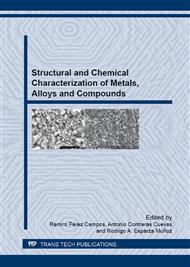p.1
p.9
p.15
p.21
p.29
p.39
p.47
p.53
Effects of Welding Conditions by TIG and Post Weld Heat Treatment in Ductile Cast Iron on the Corrosion Resistance
Abstract:
In this study ductile cast iron plates were welded by tungsten inert gas process (TIG). The objective was to evaluate the effect of filler metals; current welding and post weld heat treatment (PWHT) on the microstructure and corrosion resistance of joints. Metallographic examination of welded plates showed three different zones: fusion zone with a dendritic structure, heat affected zone with mixture of martensite and ledeburite structure and ferritic-pearlitic structure in base metal. Microstructure of welded area changes drastically to acicular ausferrite when the PWHT was applied. Corrosion rates values of 4.5 mpy were obtained in plates welded with E-FeNiCI filler metal and current of 125 and 150 A; this value is approximately half of the ones obtained in the ductile cast iron (10.5 mpy). These results are associated with: a good chemical compatibility of the filler material and ductile cast iron, increases of Ni content, refinement of the structure and a higher dissolution of graphite nodules that mitigate graphitic corrosion mechanism. The PWHT plates showed a slightly decrease in corrosion rates. In particular, plates welded with E-FeNiCI filler material and 125 A of current intensities exhibited the best corrosion resistance (3.75 mpy). This phenomenon can be attributed to homogenization of nickel in the weld bead forming passive layers that increase the corrosion resistance.
Info:
Periodical:
Pages:
21-27
Citation:
Online since:
April 2013
Authors:
Price:
Сopyright:
© 2013 Trans Tech Publications Ltd. All Rights Reserved
Share:
Citation:


